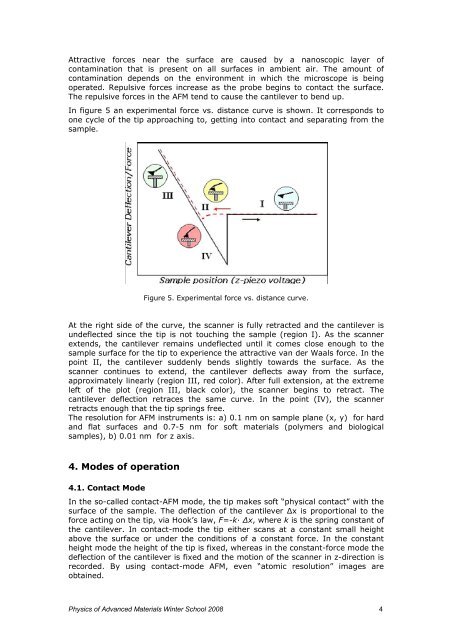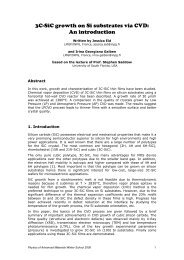Principles of Atomic rinciples Force Microscopy (AFM) - Mansic
Principles of Atomic rinciples Force Microscopy (AFM) - Mansic
Principles of Atomic rinciples Force Microscopy (AFM) - Mansic
Create successful ePaper yourself
Turn your PDF publications into a flip-book with our unique Google optimized e-Paper software.
Attractive forces near the surface are caused by a nanoscopic layer <strong>of</strong><br />
contamination that is present on all surfaces in ambient air. The amount <strong>of</strong><br />
contamination depends on the environment in which the microscope is being<br />
operated. Repulsive forces increase as the probe begins to contact the surface.<br />
The repulsive forces in the <strong>AFM</strong> tend to cause the cantilever to bend up.<br />
In figure 5 an experimental force vs. distance curve is shown. It corresponds to<br />
one cycle <strong>of</strong> the tip approaching to, getting into contact and separating from the<br />
sample.<br />
Figure 5. Experimental force vs. distance curve.<br />
At the right side <strong>of</strong> the curve, the scanner is fully retracted and the cantilever is<br />
undeflected since the tip is not touching the sample (region I). As the scanner<br />
extends, the cantilever remains undeflected until it comes close enough to the<br />
sample surface for the tip to experience the attractive van der Waals force. In the<br />
point II, the cantilever suddenly bends slightly towards the surface. As the<br />
scanner continues to extend, the cantilever deflects away from the surface,<br />
approximately linearly (region III, red color). After full extension, at the extreme<br />
left <strong>of</strong> the plot (region III, black color), the scanner begins to retract. The<br />
cantilever deflection retraces the same curve. In the point (IV), the scanner<br />
retracts enough that the tip springs free.<br />
The resolution for <strong>AFM</strong> instruments is: a) 0.1 nm on sample plane (x, y) for hard<br />
and flat surfaces and 0.7-5 nm for s<strong>of</strong>t materials (polymers and biological<br />
samples), b) 0.01 nm for z axis.<br />
4. Modes <strong>of</strong> operation<br />
4.1. Contact Mode<br />
In the so-called contact-<strong>AFM</strong> mode, the tip makes s<strong>of</strong>t “physical contact” with the<br />
surface <strong>of</strong> the sample. The deflection <strong>of</strong> the cantilever ∆x is proportional to the<br />
force acting on the tip, via Hook’s law, F=-k ∆x, where k is the spring constant <strong>of</strong><br />
the cantilever. In contact-mode the tip either scans at a constant small height<br />
above the surface or under the conditions <strong>of</strong> a constant force. In the constant<br />
height mode the height <strong>of</strong> the tip is fixed, whereas in the constant-force mode the<br />
deflection <strong>of</strong> the cantilever is fixed and the motion <strong>of</strong> the scanner in z-direction is<br />
recorded. By using contact-mode <strong>AFM</strong>, even “atomic resolution” images are<br />
obtained.<br />
Physics <strong>of</strong> Advanced Materials Winter School 2008 4




